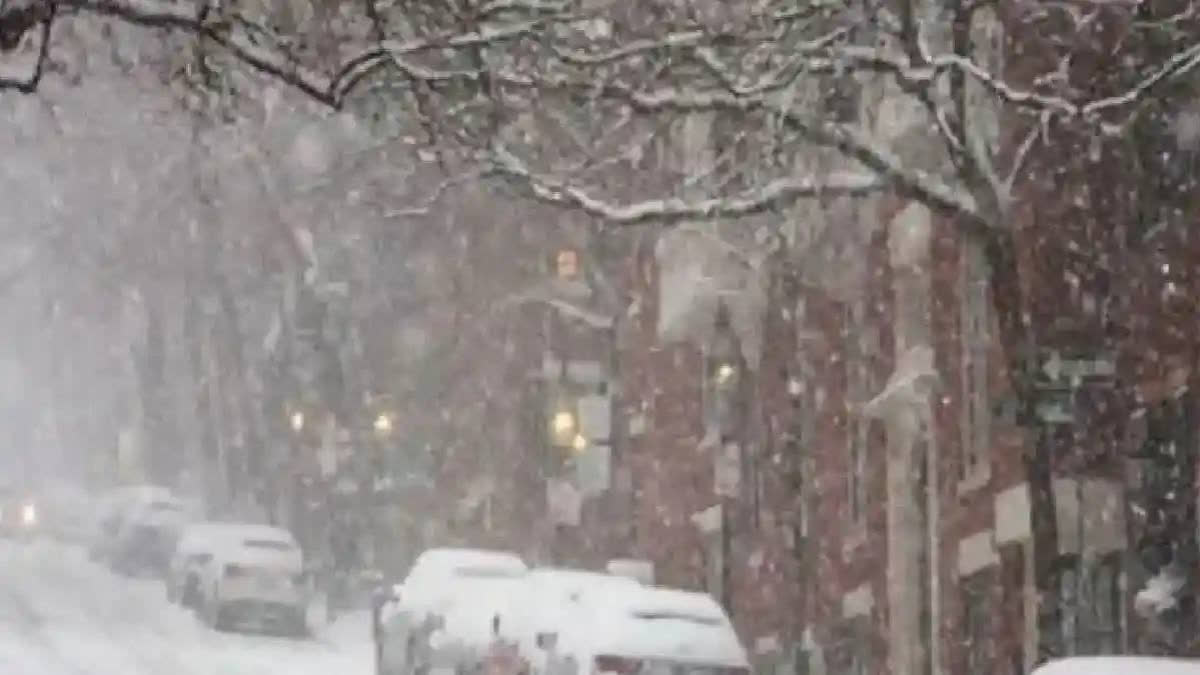Shimla:Moderate to heavy snowfall continued in high hills and tribal areas of Himachal Pradesh on Thursday while the state capital received the first snowfall of the season bringing cheers to residents, tourists and farmers. Shimla was wrapped in a thin blanket of snow on Thursday while the 5-km stretch between Kufri and Fagu was entirely covered in snow. Braving the cold, tourists and residents thronged the Mall Road and Ridge in the heart of the city to enjoy the snow.
Shimla was lashed by a severe hailstorm on Wednesday night followed by intermittent rains. Over 566 roads, including six national highways, in the state have been closed for vehicular traffic following heavy snowfall and rain, said Public Works Department Minister Vikramaditya Singh, adding that 138 roads are expected to be opened by tonight.
Machinery in low areas have been shifted to snow-bound areas in a proactive move and calcium chloride is being sprinkled to clear roads, Singh said. He added that the public works department has so far suffered a loss of Rs 4.5 crore due to snowfall. The vehicular traffic in the upper Shimla area beyond Dhalli came to a standstill as the roads got blocked due to heavy snow in Kufri, Fagu and Narkanda on Thursday afternoon.
Vehicular movement which was earlier halted in upper Shimla areas in Dhalli is now being regulated, Shimla SP Sanjeev Kumar Gandhi told PTI on Thursday. He said man and machinery are at place and vehicles would be allowed once the roads are considered safe for commute. The local MeT office has issued orange warning for heavy snow and at isolated places in five districts -- Shimla, Kullu, Chamba, Kinnaur and Lahaul and Spiti on February 1 and yellow alert for thunderstorm and lightning on February 3 and 4.
The ongoing weather activity will reduce gradually by Thursday evening and the weather is likely to remain dry on Friday. However, more rain is likely from the evening of February 3, MeT official Sandeep Sharma said. The forecast for heavy snowfall has brought relief to the farmers and the fruit and vegetable growers, who suffered huge crop losses due to the prolonged dry spell.
The wet spell is likely to be beneficial for the Rabi crops, a spokesperson of the agriculture department said. "The heavy snowfall has brought cheers to the tourism and allied industry and we are pinning hope for a good season in February. The footfall is likely to increase due to snowfall during the weekends in Shimla," said M K Seth, president of Shimla Hotel and Tourism Stakeholders Association.
The famous tourist destinations of Narkanda, Kufri, Shimla, Manali, Rohtang, Sangla, Dalhousie and Khajjiar are also receiving snowfall. Some vehicles in Manali and suburbs were damaged as uprooted trees fell on them. Chidgaon in Shimla district recorded 75-cm deep followed by Shikari Mata receiving 60 cm snow, Kothi 50 cm, Chanshel and Kamru Nag 45 cm each, Manali 37 cm, Keylong 32 cm, Bada Bangal and Prashar Lake 30 cm, Tindi, Pangi, Jot and Nauradhar 25 cm each, Kukumseri 18.4 cm, Koksar 16.2 cm, Khadrala 16 cm and Shillaroo 15 cm.
Widespread rains lashed several parts of the state and Mehre was the wettest with 50 mm of rain followed by Bhoranj 45 mm, Rohru 40 mm mm, 33 mm in Bhuntar, 23 mm each in Kangra and Mandi, 22 mm in Una, 20 mm each. The cold wave conditions persisted in the lower hills and dense fog occurred at some place in the morning hours. Kukumseri was the coldest at night recording a minimum temperature at minus 3.1 degrees Celsius while Kalpa shivered at minus 2.4 degrees Celsius, Narkanda and Samdho at minus 2.1 degrees Celsius, Manali minus 0.1 degrees Celsius, Dalhousie 0.9 degrees Celsius, Kufri 0.2 degrees Celsius and Shimla at 1.8 degrees Celsius.
As per the MeT, three or four spells of heavy rain or snowfall are likely in Lahaul-Spiti, Shimla, Kinnaur, Chamba, Kangra, Kullu and Mandi during this period. The state witnessed the driest January in 2022 with about 99 per cent rain deficit and 83 per cent rain deficit in December 2023. The MeT has predicted a wet spell in the state till February 5.The snowfall is likely to cause disruption of essential services like water, electricity, communications and related services and reduce visibility, the forecast said.
